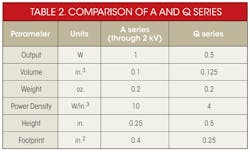High Voltage Power Supply Module Size Is Shrinking
Following a lead from their low voltage cousins, high voltage power supplies have moved to modular localized solutions, although high voltage must be treated very differently. High voltage power supply designers face the same problems as low voltage designers, plus the additional constraints of physics, chemistry, and topology. In the past, this task was left to specialists who usually had to create a new design for each application — there was very little standardization. Plus, high voltage supplies tended to be oversized for their power rating to allow extra spacing of the internal wiring and components. Then there was the problem of safely routing the high voltage output to its load. As the number of applications requiring high voltage grew, there was pressure to change this early design strategy.
Related Articles
- 24 V DC/DC Converters Meet High-Voltage Needs
- High-Voltage AC/DC Module Produces Up To 12 kV
- Package Innovations Boost Power Conversion IC Current Density
- Power Packaging Spins New Automotive Capabilities
- Better Power Packages Make Better Circuits
- Innovative Packaging Shrinks 600 mA and 6 A Power Supplies
- Where are the High-Voltage GaN Products?
To meet this challenge, high voltage power supply manufacturers designed proprietary methods to build off-the-shelf modules in very small standard packages that could be used in much the same way as low voltage power modules. Producing high voltage requires a transformer plus rectifiers and capacitors. At 60 Hz, these components have to be large. The first generation high voltage module designers therefore understood that the key to significantly reducing size was to work at relatively high frequencies rather than 60 Hz. Their approach was to start with low voltage DC, typically in the range of 12 to 28 Vdc, and then to use an oscillator-based inverter circuit to produce a low voltage, high-frequency input for the transformer.
High frequency enabled reductions in size, especially for the transformers and capacitors. However, high voltage engineers were still faced with a serious problem that low voltage engineers didn’t have to worry about — the possibility of arcing between high voltage points and between high voltage and ground. This meant that there were limits to how small these supplies could be made, and still ensure reliable operation. High voltage never stops looking for, and creating, pathways to escape being confined; therefore unique topologies were developed to achieve the long-term reliability demanded by end users. Another part of the solution to that problem was in developing encapsulation techniques that enabled the spacing for high voltages to be significantly reduced, while at the same time allowing adequate heat dissipation.
The First Generation Arrives
Armed with these tools, EMCO High Voltage Corporation and others developed families of reliable, miniature, small-footprint standard modules that they built in large numbers, thus enabling users to count on their availability for new designs. The modules are generally available in one of two basic types.
The proportional supply is less expensive and provides more power per cubic inch. Proportional supply modules are used in various ways where the output voltage varies linearly with the input supply voltage. If the voltage required by the load is not critical — for example, for electrostatic air cleaners — a proportional supply can be used without special control circuits. The output voltage can be adjusted by varying the input.
The other type is the regulated supply that is used if the high voltage needs to be constant when the load or the input voltage varies. Regulated supplies are stabilized by internal components against variations of load current, input voltage, and temperature. Sampling the output voltage and feeding it to an error amplifier that controls the inverter circuit is one way to accomplish this.
Over the past 10 years, DC-to-DC high voltage converters have proven themselves to be effective, efficient, and reliable. Next-generation technology is retaining those qualities and is further pushing the boundaries of watts per cubic inch, reduced power consumption, and the addition of smart features for control and safety. Comparing the present generation of several EMCO high voltage power supplies with the models that they have replaced provides a good illustration of these trends.
Table 1 compares the current generation FS series (Fig. 1) 10-W power supplies with its predecessor, the F series. Table 2 compares the A series (Fig. 2) and Q series; two ultra-miniature power supplies. The higher power AH series and QH series are compared in Table 3.
The ULP series (Fig. 3) of miniature regulated and programmable high voltage supplies is designed for battery powered portable equipment. Mobile and airborne applications use the ULP series where consideration for light weight, small payload size, and long periods of operation are required. Providing up to 4 watts of output, the ULP series can operate no-load for up to 4500 hours from two lithium AA batteries. Characteristics of the ULP series are given in Table 4.
More information can be obtained by contacting EMCO at http://www.emcohighvoltage.com.








